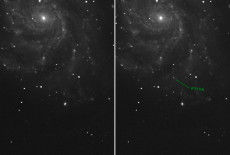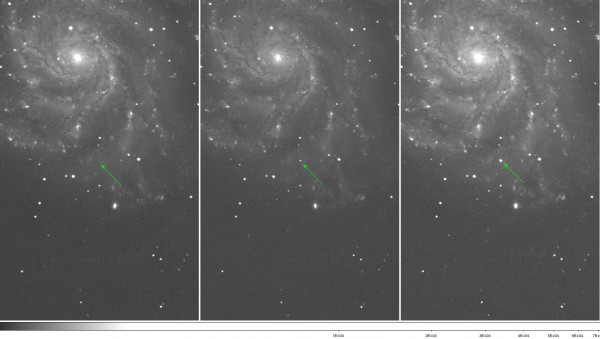Supernova Caught in the Act
Earliest-ever Detection Made Possible by Computing, Networks
August 25, 2011
By Linda Vu
Contact: cscomms@lbl.gov

Before and after images of supernova PTF 11kly as it appeared in the nearby M101 galaxy. Click to enlarge. (Images: Peter Nugent)
A supernova discovered yesterday is closer to Earth—approximately 21 million light-years away—than any other of its kind in a generation. Astronomers believe they caught the supernova within hours of its explosion, a rare feat made possible by a specialized survey telescope and state-of-the-art computational tools.
The discovery of such a supernova so early and so close has energized the astronomical community as they are scrambling to observe it with as many telescopes as possible, including the Hubble Space Telescope.
Joshua Bloom, assistant professor of astronomy at the University of California, Berkeley, called it “the supernova of a generation.” Astronomers at Lawrence Berkeley National Laboratory (Berkeley Lab) and UC Berkeley, who made the discovery predict that it will be a target for research for the next decade, making it one of the most-studied supernova in history.
The supernova, dubbed PTF 11kly, occurred in the Pinwheel Galaxy, located in the “Big Dipper,” otherwise known as the Ursa Major constellation. It was discovered by the Palomar Transient Factory (PTF) survey, which is designed to observe and uncover astronomical events as they happen.
Want to see it for yourself? Berkeley Lab astronomer Peter Nugent explains how
“We caught this supernova very soon after explosion. PTF 11kly is getting brighter by the minute. It’s already 20 times brighter than it was yesterday,” said Peter Nugent, the senior scientist at Berkeley Lab who first spotted the supernova. Nugent is also an adjunct professor of astronomy at UC Berkeley. “Observing PTF 11kly unfold should be a wild ride. It is an instant cosmic classic.”
He credits supercomputers at the National Energy Research Scientific Computing Center (NERSC), a Department of Energy supercomputing center at Berkeley Lab, as well as high-speed networks with uncovering this rare event in the nick of time.
The PTF survey uses a robotic telescope mounted on the 48-inch Samuel Oschin Telescope at Palomar Observatory in Southern California to scan the sky nightly. As soon as the observations are taken, the data travels more than 400 miles to NERSC via the National Science Foundation’s High Performance Wireless Research and Education Network and DOE’s Energy Sciences Network (ESnet). At NERSC, computers running machine learning algorithms in the Real-time Transient Detection Pipeline scan through the data and identify events to follow up on. Within hours of identifying PTF 11kly, this automated system sent the coordinates to telescopes around the world for follow-up observations.

These images (click to enlarge) show Type Ia supernova PTF 11kly, the youngest ever detected, over the past three nights. The left image taken on August 22, 2011, shows the star (to the lower right of the glaxay) shortly before it exploded, approximately 1 million times fainter than the human eye can detect. The center image taken on August 23 shows the supernova at about 10,000 times fainter than the human eye can detect. The right image taken on August 24 shows the event six times brighter than the previous day. In two weeks time it should be visible with a good pair of binoculars. (Images: Peter Nugent)
Three hours after the automated PTF pipeline identified this supernova candidate, telescopes in the Canary Islands (Spain) had captured unique “light signatures,” or spectra, of the event. Twelve hours later, his team had observed the event with a suite of telescopes including the Lick Observatory (California), and Keck Observatory (Hawaii) had determined the supernova belongs to a special category, called Type Ia. Nugent notes that this is the earliest spectrum ever taken of a Type Ia supernova.
“Type Ia supernova are the kind we use to measure the expansion of the Universe. Seeing one explode so close by allows us to study these events in unprecedented detail,” said Mark Sullivan, the Oxford University team leader who was among the first to follow up on this detection.
“We still do not know for sure what causes such explosions,” said Weidong Li, senior scientist at UC Berkeley and collaborator of Nugent. “We are using images from the Hubble Space Telescope, taken fortuitously years before an explosion to search for clues to the event’s origin.”
The team will be watching carefully over the next few weeks, and an urgent request to NASA yesterday means the Hubble Space Telescope will begin studying the supernova’s chemistry and physics this weekend.
Catching supernovae so early allows a rare glimpse at the outer layers of the explosion, which contain hints about the star it once was. “When you catch them this early, mixed in with the explosion you can actually see unburned bits from the star that exploded! It is remarkable,” said Andrew Howell of UC Santa Barbara/Las Cumbres Global Telescope Network. “We are finding new clues to solving the mystery of the origin of these supernovae that has perplexed us for 70 years. Despite looking at thousands of supernovae, I’ve never seen anything like this before.”
“The ability to process all of this data in near real-time and share our results with collaborators around the globe through the Deep Sky Science Gateway at NERSC is an invaluable tool for following up on supernova events,” says Nugent. “We wouldn’t have been able to detect and observe this candidate as soon as we did without the resources at NERSC.”
At a mere 21 million light-years from Earth, a relatively small distance by astronomical standards, the supernova is still getting brighter, and might even be visible with good binoculars in ten days' time, appearing brighter than any other supernova of its type in the last 30 years.
“The best time to see this exploding star will be just after evening twilight in the Northern hemisphere in a week or so,” said Oxford’s Sullivan. “You’ll need dark skies and a good pair of binoculars, although a small telescope would be even better.”
The scientists in the PTF have discovered more than 1,000 supernovae since it started operating in 2008, but they believe this could be their most significant discovery yet. The last time a supernova of this sort occurred so close was in 1986, but Nugent notes that this one was peculiar and heavily obscured by dust.
"Before that, you'd have to go back to 1972, 1937 and 1572 to find more nearby Type Ia supernovae,” says Nugent.
The Palomar Transient Factory is a survey operated a Palomar Observatory by the California Institute of Technology on behalf of a worldwide consortium of partner institutions. Collaborators on PTF 11kly with Nugent, Bloom and Li are Brad Cenko, Alex V. Filippenko, Geoffrey Marcy, Adam Miller (UC Berkeley), Rollin C. Thomas (Lawrence Berkeley National Laboratory), Sullivan (Oxford University), and Andrew Howell (UC Santa Barbara/Las Cumbres Global Telescope Network).
Read more about how NERSC supports the Palomar Transient Factory.
About NERSC and Berkeley Lab
The National Energy Research Scientific Computing Center (NERSC) is a U.S. Department of Energy Office of Science User Facility that serves as the primary high performance computing center for scientific research sponsored by the Office of Science. Located at Lawrence Berkeley National Laboratory, NERSC serves almost 10,000 scientists at national laboratories and universities researching a wide range of problems in climate, fusion energy, materials science, physics, chemistry, computational biology, and other disciplines. Berkeley Lab is a DOE national laboratory located in Berkeley, California. It conducts unclassified scientific research and is managed by the University of California for the U.S. Department of Energy. »Learn more about computing sciences at Berkeley Lab.







